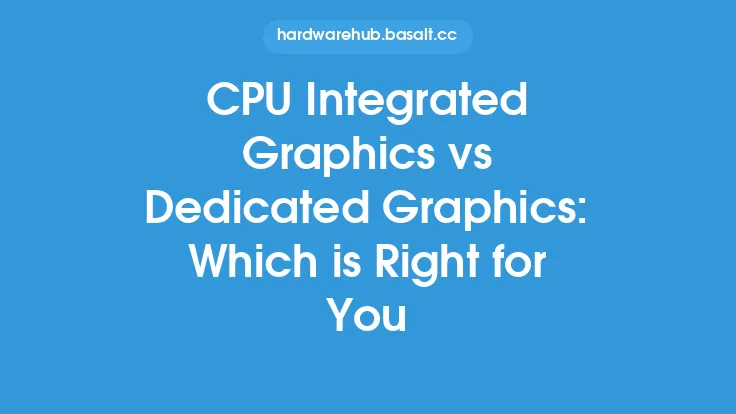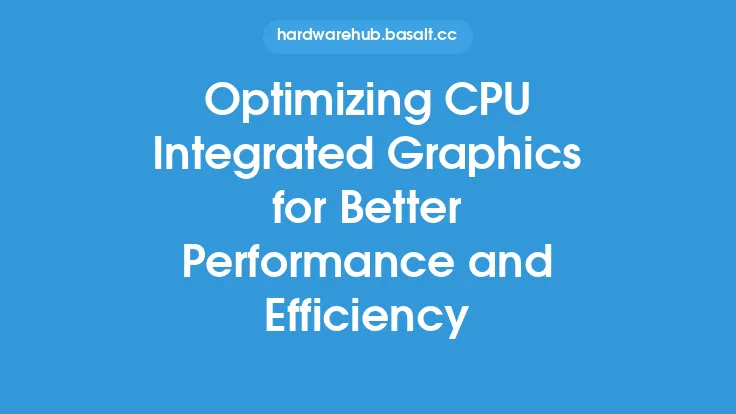The concept of integrated graphics has been around for several decades, and it has undergone significant transformations over the years. At its core, integrated graphics refers to the graphics processing unit (GPU) that is built directly into the central processing unit (CPU) or the motherboard. This design approach has several benefits, including reduced power consumption, lower costs, and improved overall system performance. In this article, we will delve into the benefits and limitations of CPU integrated graphics, exploring the technical aspects and the implications for various use cases.
Benefits of CPU Integrated Graphics
CPU integrated graphics offer several advantages over dedicated graphics cards. One of the primary benefits is reduced power consumption. Since the GPU is integrated into the CPU, it can share the same power supply and heat dissipation system, resulting in lower overall power draw. This makes integrated graphics an attractive option for laptops, tablets, and other mobile devices where power efficiency is crucial. Additionally, integrated graphics tend to be more cost-effective than dedicated graphics cards, as they eliminate the need for a separate GPU and its associated costs.
Another significant benefit of CPU integrated graphics is improved overall system performance. By integrating the GPU into the CPU, the system can take advantage of the CPU's cache hierarchy and memory bandwidth, resulting in faster graphics processing and reduced latency. This is particularly important for applications that rely heavily on graphics processing, such as video editing, 3D modeling, and gaming. Furthermore, integrated graphics can also provide better support for general-purpose computing on graphics processing units (GPGPU), which enables the GPU to be used for non-graphics tasks such as scientific simulations, data analytics, and machine learning.
Limitations of CPU Integrated Graphics
While CPU integrated graphics offer several benefits, they also have some significant limitations. One of the primary limitations is performance. Integrated graphics tend to be less powerful than dedicated graphics cards, which can result in lower frame rates, reduced graphics quality, and limited support for demanding graphics applications. This is because integrated graphics typically have limited processing power, memory bandwidth, and thermal headroom, which can constrain their performance.
Another limitation of CPU integrated graphics is the lack of dedicated video memory. Unlike dedicated graphics cards, which have their own dedicated video random access memory (VRAM), integrated graphics typically share the system's main memory (RAM) with the CPU. This can result in reduced graphics performance, as the GPU must compete with the CPU for access to the shared memory. Furthermore, integrated graphics may also lack support for advanced graphics features such as multi-monitor support, 4K resolution, and high-dynamic-range (HDR) rendering.
Technical Aspects of CPU Integrated Graphics
From a technical perspective, CPU integrated graphics are designed to provide a balance between performance and power efficiency. The GPU is typically implemented as a system-on-chip (SoC) design, where the GPU, CPU, and other system components are integrated onto a single piece of silicon. This design approach enables the GPU to share resources with the CPU, such as cache memory and memory bandwidth, which can improve overall system performance.
The GPU itself is typically designed using a variety of architectures, including Intel's HD Graphics, AMD's Radeon Graphics, and NVIDIA's GeForce Graphics. These architectures provide a range of features, including support for DirectX, OpenGL, and Vulkan, as well as hardware acceleration for tasks such as video decoding and encoding. The GPU is also typically paired with a display controller, which manages the output of graphics data to the display device.
Implications for Various Use Cases
The benefits and limitations of CPU integrated graphics have significant implications for various use cases. For example, in the case of general computing, integrated graphics are often sufficient for tasks such as web browsing, office work, and streaming media. However, for more demanding tasks such as gaming, video editing, and 3D modeling, dedicated graphics cards may be required to provide the necessary performance and features.
In the case of mobile devices, integrated graphics are often the preferred choice due to their low power consumption and reduced heat generation. However, this can result in reduced graphics performance, which may be a limitation for users who require more demanding graphics capabilities. In contrast, desktop systems often have more flexibility in terms of graphics options, and users may be able to choose between integrated graphics and dedicated graphics cards depending on their specific needs and budget.
Conclusion
In conclusion, CPU integrated graphics offer a range of benefits, including reduced power consumption, lower costs, and improved overall system performance. However, they also have significant limitations, including reduced performance, limited support for advanced graphics features, and lack of dedicated video memory. By understanding the technical aspects and implications of CPU integrated graphics, users can make informed decisions about their graphics needs and choose the best option for their specific use case. Whether it's for general computing, gaming, or other applications, CPU integrated graphics play an important role in modern computing, and their continued evolution and improvement will be critical to meeting the growing demands of graphics-intensive applications.





